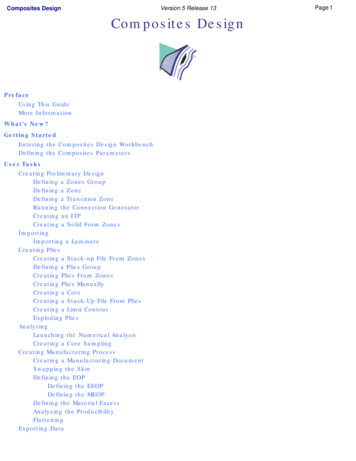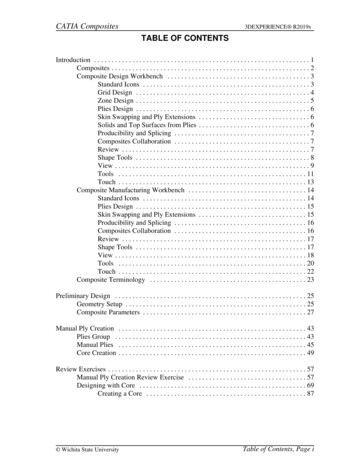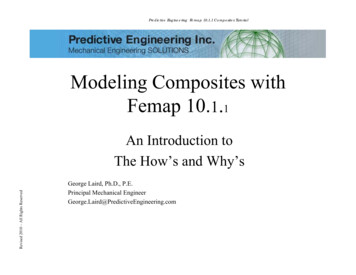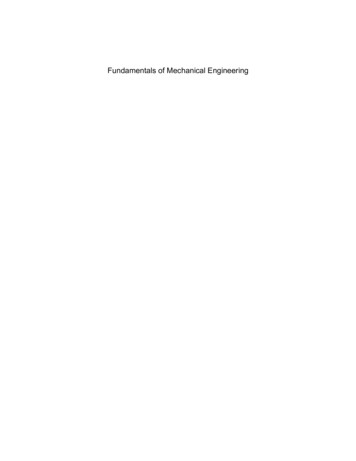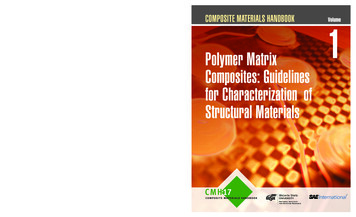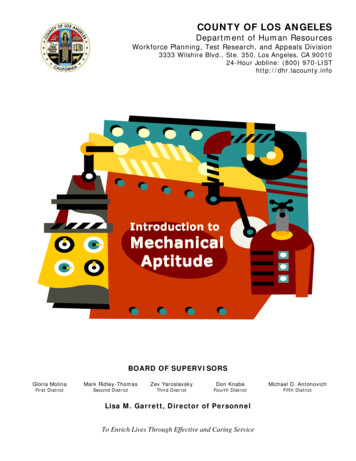
Transcription
Mechanical Testing ofComposites 2003, P. Joyce
Tests Accepted by Mil-Hdbk-17Test CategorySource of Test MethodASTMSACMAD2539, C613D5300RM 23, RM 24Volatiles contentD3530--Resin flowD3531RM 22Resin gel timeD3532RM 19Fiber areal weightD3776RM 23, RM 24Moisture contentD4019--Tack----HPLC--RM 20E1252, E168--D4065, D4473RM 19E1356RM 25Prepreg testsResin contentIRDMA (RDS)DSC 2003, P. Joyce
Tests Accepted by Mil-Hdbk-17Test CategorySource of Test MethodASTMSACMAD5229RM 11Fiber volumeD3171, D2734RM 10Resin contentD3171, D2734RM 10Void contentD2584--D792, D1505----RM 10D4065RM 18--RM 18E831--D696, E228--Equilibrium moisture contentD5229RM 11Moisture diffusivityD5229--Thermal diffusivityE1461 2003, P. JoyceE1269--Lamina physical testsMoisture conditioningDensityCured ply thicknessGlass transition temperature (dry)Glass transition temperature(wet)CTE, out-of-planeCTE, in-planeSpecific heat--
Tests Accepted by Mil-Hdbk-17Test CategorySource of Test MethodASTMSACMA0 /Warp tensionD3039RM 4, RM 990 /Fill tensionD3039, D5450RM 4, RM 90 /Warp compressionD3410, D5467RM 1, RM 690 /Fill compressionD3410, D5449RM 1, RM 6D3518, D5448, D5379RM 7Interlaminar shearD5379--Short beam shearD2344RM 8----draftRM 5Lamina/LaminateMechanical TestsIn-plane shearFlexureOpen-Hole Compression 2003, P. Joyce
Tests Accepted by Mil-Hdbk-17Test CategorySource of Test MethodASTMSACMAOpen-Hole TensionD5766RM 5Single shear bearingdraft--Double-shear bearingdraft--Compression after impactdraftM2Mode I fracture toughnessD5528--Mode II fracture al Tests (cont.)Tension/tension fatigueTension/compression fatigue 2003, P. Joyce
Laminate Testing¾ ASTM D638 Tensile Properties of Plastics – dogbone specimen 2003, P. Joyce
Laminate Testing¾ ASTM D3039 TensileProperties of PMCMaterials¾ Used for mostaerospace composites 2003, P. Joyce
Laminate Testing¾ ASTM D695 Compressive Properties of Rigid Plastics (1942)¾ Uses an untabbed, dogboned, flat specimen 2003, P. Joyce
Laminate Testing¾ Modified D695 Compression Test Method¾Uses a straight sided specimen¾Tabbed for strength (gage length to short to instrument using strain gages)¾Untabbed for modulus¾No ASTM standard governing this method¾Defined in Boeing Specification Support Standard (BSS 7260, 1982) andSACMA Recommended Test Method (SRM 1-88, 1988) 2003, P. Joyce
Laminate Testing¾ Modified ASTM D695 - Mil-Hdbk-17 interprets this technique to befor 0 direction properties of unidirectional coupons, and 0 and 90 properties of fabric coupons only (and then only when unit cell size ofweave or braid is small.) 2003, P. Joyce
Laminate Testing¾ ASTM D3410 Compressive Properties of PMCMaterials by Shear Loading¾ Standard for high modulus carbon fiber composites (1980s)¾ 0.5” gage length for strain gage sometimes buckles.¾ Tab failure also problematic.Celanese fixture 2003, P. Joyce
Laminate Testing¾ ASTM D3410 Compressive Properties of PMCMaterials by Shear Loading¾ Standard for high modulus carbon fiber composites (1980s)¾ 0.5” gage length for strain gage sometimes buckles.¾ Tab failure also problematic.IITRI fixture 2003, P. Joyce
Laminate Testing¾ ASTM D6641 Compressive Properties using CLCFixture (2001)¾ Evolved out of WTF ELSS fixture¾ Uses straight sided, untabbed specimen¾ Not recommended for unidirectional composites 2003, P. Joyce
Laminate Testing¾ ASTM D2344 Short-Beam Strength of PMC Materials¾ Low cost QC test¾ Material screening 2003, P. Joyce
Laminate Testing¾ ASTM D5379 Shear Properties of Composite Materialsby the V Notched Beam Method (Iosipescu) 2003, P. Joyce
Laminate Testing(Iosipescu method) 2003, P. Joyce
Laminate Testing¾ ASTM D3518 In-plane Shear (IPS)¾ Uses 45 laminate to extract shear properties.¾ Strictly a shear design allowable¾ Not used for QC 2003, P. Joyce
Laminate Testing¾ ASTM D790 Flexural Properties of Un-Reinforced andReinforced Plastics 2003, P. Joyce
Laminate Testing¾ASTM D6484 Open Hole Compressive Strength of PMCLaminates (1999)¾After Boeing Specification Support Standard BSS 7260,also described in SACMA Recommended Method SRM 3-88. 2003, P. Joyce
Laminate Testing¾ASTMD6742 Filled Hole Tensile/Compressive StrengthwNe Laminates (2002)of PMC 2003, P. Joyce
Laminate Testing¾Creep testing¾Creep is defined as the change in a propertyover time when subjected to a constant forcingfunction.¾Creep should be considered if the end use¾involves high stress in the matrix dominateddirection¾high temperature¾or exposure to a harsh chemical environment 2003, P. Joyce
Laminate Testing¾Creep is especially important in composites witha thermoplastic matrix, particularly as TsÆTg¾Creep is expected to be small in thermoset matrixcomposites, due to cross-linking.¾Creep testing is not used to provide primarydesign data, rather designs should be checked forcreep deformation. 2003, P. Joyce
Testing Fabric-Reinforced“Textile” Composites¾Refer to ASTM D 6856 Standard Guide for . . .¾Discusses special testing considerations fortextile composites. 2003, P. Joyce
Adhesives Testing¾ ASTM D1002 Single Lap Shear is the most common &industry standard test for:¾ QC in-process inspection to verify mixing, cure, and surface preparation.¾ Screening for materials selection.“five finger” Al specimens 2003, P. JoyceSpecimens machined fromcomposite laminate
Adhesives Testing¾ ASTM D3528 Double Lap Shear minimizes peel, resultsin higher, more consistent shear strength.TypeTypeABspecimenspecimen 2003, P. Joyce
Adhesives Testing¾ ASTM D3165 Notched Lap Shear¾ QC for large laminated assemblies (voids)¾ Compatibility of different resin systems 2003, P. Joyce
Adhesives Testing¾ ASTM D1780 Adhesive Creep¾ Apply constant load andmeasure deflection of scribemarks. 2003, P. Joyce
Adhesives Testing¾ ASTM D1876 Tee Peel¾ Requires two flexible adherends (Al) 2003, P. Joyce
Adhesives Testing¾ ASTM D3167 FloatingRoller (Bell) Peel¾ One rigid, one flexibleadherend 2003, P. Joyce
Sandwich Testing¾ ASTM C297 Flatwise Tensile Strength of SandwichConstructions (used as workmanship verification, unless veryreliable NDE being used.) 2003, P. Joyce
Sandwich Testing¾ ASTM C393 “Long Beam” Flexure¾ 4 point bending produces uniform bending moment in the center section.¾ Specimen is sized to induce compression failure in upper skin, not coreshear.¾ Also demonstrates that skin to core strength is adequate to achievedesigned facesheet compression stress.Paste Photo Here 2003, P. Joyce
Sandwich Testing¾ ASTM C393 Beam Flexure¾ Performed in addition to FWT on co-cured sandwich ifrigorous structural requirement.¾ Accounts for any knockdown from wrinkling/dimpling.¾ Usually yields lower strength & modulus than solid facesheettension or compression test. 2003, P. Joyce
Sandwich Testing¾ Mil-Std 401B Core Shear¾ Used to verify core splice performance.¾ Can also be used to compare different surface preparations.¾ Standard configuration uses¾ 0.062” Al facesheets¾ 8.1 pcf Al core 2003, P. Joyce
Sandwich Testing¾ ASTM D1781 Climbing Drum Peel¾ Used for characterization of adhesives for Al facesheet construction¾ Workmanship test 2003, P. Joyce
References¾¾¾¾¾¾Course Notes, Test Methods for Composite Materials, Adams, D. (1991)Mil-Hdbk-17 Composite Materials HandbookMil-Hdbk-23A Structural Sandwich CompositesWyoming Test Fixtures, Product Catalog No. 106 (2000)ASTM Annual Book of Standards (2001)Engineering Mechanics of Composite Materials, Daniel, I.M. and Ishai, O. (1994) 2003, P. Joyce
Tests Accepted by Mil-Hdbk-17 Test Category Source of Test Method ASTM SACMA Lamina/Laminate Mechanical Tests 0 /Warp tension D3039 RM 4, RM 9 90 /Fill tension D3039, D5450 RM 4, RM 9 0 /Warp compression D3410, D5467 RM 1, RM 6 90 /Fill compression D3410, D5449 RM 1, RM 6 In-plane shear D3518, D5448, D5379 RM 7 Interlaminar shear D5379 --
